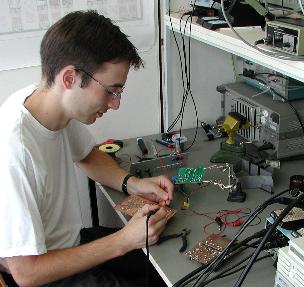Selection of Professorship's R&D Results
- Design, production and characterization of a pressure sensor based on the piezoelectric effect in MOSFETs
- Design of a 12-bit analog-to-digital converter in a 0.18 µm technology
- Design of a digital-to-analog converter in a 0.18 µm CMOS technology
- Design and building of a 6 kW tube-based tesla transformer
- Design and production of a 10-bit SAR analog-to-digital converter in a 0.35 µm technology
- Design of a MSP430 microcontroller core for the application in integrated sensor systems
- Design and production of a configurable 8051-compatible microcontroller
- Development of charge-sensitive yarn speed sensors for textile machines
- Design and layout of circuit variants for the signal evaluation of piezoresistive pressure sensors
- Design and characterization of an electronical adjustable, temperature-stable RC oscillator in a 0.25 µm semiconductor technology
- Development and characterization of a four-channel multiplexer in a 0.25 µm semiconductor technology
- Development of an integrated sensor signal evaluation circuit on the principle of sigma-delta modulation
- Modeling and optimization of trench isolation structures in integrated circuits for voltages up to 650 V
- Development of an integrated low-noise CMOS operational amplifiers for low voltages
- Design of a RF system with bidirectional data transfer
- Development and production of a Vertical FET in near-surface Si bulk micromechanics
- Development of a TLP measuring station for isothermal characteristic curve recording of electronic devices
- Creation of models for DMOS transistors and integrated polysilicon resistors
- Development of novel solar cells based on negatively charged drift field sources
- Design of an integrated high-voltage amplifier with protection circuits for array applications
- CCD camera control for a spectral imaging scanner technology
- Switched-capacitor correlation analysis in CMOS technology
- Development and building of a digital PID controller for temperature regulation
- Development and building of a measuring station for illuminated I-V curves of solar cells; creation of driving / signal evaluation software for Windows NT
- Development and building of an efficient analog front-end for a microcontroller for spectral detection of sensor signals
- Development and building of a noise and crosstalk simulator for sensor arrays
- Design and production of a monolithic integrated low-noise CMOS transimpedance amplifier for driving resp. signal evaluation of a Si resonator (chip photo, results)
- Design and production of a SC balanced modulator for lock-in recovery of noisy signals (function principle, chip photo)
- Design and production of an 800 V amplifier for driving capacitive microactuators (chip photo, oscillogram)
- Development of high-voltage DMOS simulation models for IC design using the macro model approach (results)
- Development of a Mentor Graphics designkit for the DIMOST technology (alpha microelectronics, 450 V)
- Programming of a GDS2 interface for the anisotropic etching simulator SiMODE
- Works on an interface between the simulators ANSYS and SiMODE
- Development and verification of an HDLA model for pressure sensors
- Test system-based development of models for Spice-compatible simulators
- Development, modeling and production of cheap highly effective solar cells
- Development and building of noise-optimized amplifiers for sensor signal evaluation
- Development and building of a sun simulator for a solar cell measuring station
- Development and building of a Lock-in amplifier module with multiplying D/A converter
- Development and building of a modulierbaren 500 V high-voltage amplifier with modulation capability and driving unit
- Development and building of a temperature control module for a measure and calibration system
- Development and building of a high temperature suitable microprocessor-controlled pressure measurement device
- Development and building of an air pressure gauge
- Development and building of an universal PIC-controlled sensor evaluation module
- Development and production of a 3D graphics card for personal computers

- Important material constants of semiconductors
- Material data base (within the ET/IT domain)





